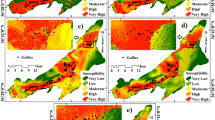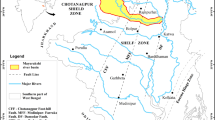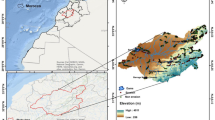Abstract
Hot and humid subtropical plateau regions are susceptible to land degradation in the form of weathering and gully erosion. Here, we investigate chemical weathering, gully erosion and cohesiveness through field-based measurements with a view to understand the controlling factors of potential land degradation, in complex river basin of the Chotanagpur plateau region in Eastern India. The layers of controlling factors of gully erosion were developed and prioritized considering boosted regression tree (BRT), alternative decision tree (ADT), particle swarm optimization (PSO) and random forest (RF) algorithms in the R software, and the results of these methods were also validated using receiver operating characteristic (ROC) curves. The spectroscopic analysis was carried out of collected soil samples to measure the degree of chemical weathering and cohesiveness. Furthermore, the climatic elements like temperature and rainfall were also considered for estimating the chemical weathering. The results of the gully erosion models (i.e., BRT, ADT, PSO and RF) show remarkable accuracy with ROC values of 0.93, 0.89, 0.91 and 0.84, respectively. An advanced decision tree model was integrated with the results of degree of chemical weathering and cohesiveness in geographical information system platform. The land degradation map developed from this approach shows that 10.53% of the study area is highly affected, whereas 17.36% area is moderately affected and the rest of the 73.85% area is less affected by land degradation. Our results provide essential information for policy makers in adopting measures for minimizing and controlling the land degradation. Our novel approach is significant to assess land degradation to a large scale.















Similar content being viewed by others
References
Abdmouleh Z, Gastli A, Ben-Brahim L et al (2017) Review of optimization techniques applied for the integration of distributed generation from renewable energy sources. Renewable Energy 113:266–280
Achour Y, Pourghasemi HR (2020) How do machine learning techniques help in increasing accuracy of landslide susceptibility maps? Geosci Front 11:871–883
Alin A (2010) Multicollinearity. Wiley Interdiscip Rev Comput Stat 2:370–374. https://doi.org/10.1002/wics.84
Arabameri A, Asadi Nalivan O, Chandra Pal S et al (2020) Novel machine learning approaches for modelling the gully erosion susceptibility. Remote Sens 12:2833. https://doi.org/10.3390/rs12172833
Arabameri A, Chandra Pal S, Costache R et al (2021a) Prediction of gully erosion susceptibility map** using novel ensemble machine learning algorithms. Geomat Nat Haz Risk 12:469–498
Arabameri A, Pal SC, Rezaie F et al (2021b) Comparison of multi-criteria and artificial intelligence models for land-subsidence susceptibility zonation. J Environ Manag 284:112067
Arabameri A, Pal SC, Rezaie F et al (2021c) Decision tree based ensemble machine learning approaches for landslide susceptibility map**. Geocarto Int. https://doi.org/10.1080/10106049.2021.1892210
Band SS, Janizadeh S, Chandra Pal S et al (2020) Novel ensemble approach of deep learning neural network (DLNN) model and particle swarm optimization (PSO) algorithm for prediction of gully erosion susceptibility. Sensors 20:5609
Bhandari PM, Bhadwal S, Kelkar U (2007) Examining adaptation and mitigation opportunities in the context of the integrated watershed management programme of the Government of India. Mitig Adapt Strat Glob Change 12:919–933
Bhattacharyya R, Ghosh BN, Mishra PK et al (2015) Soil degradation in India: challenges and potential solutions. Sustainability 7:3528–3570
Bossio D, Geheb K, Critchley W (2010) Managing water by managing land: addressing land degradation to improve water productivity and rural livelihoods. Agric Water Manag 97:536–542
Buston PM, Elith J (2011) Determinants of reproductive success in dominant pairs of clownfish: a boosted regression tree analysis. J Anim Ecol 80:528–538
Chakrabortty R, Pal SC, Chowdhuri I et al (2020a) Assessing the importance of static and dynamic causative factors on erosion potentiality using SWAT, EBF with uncertainty and plausibility, logistic regression and novel ensemble model in a sub-tropical environment. J Indian Soc Remote Sens 48:765–789. https://doi.org/10.1007/s12524-020-01110-x
Chakrabortty R, Pal SC, Sahana M et al (2020b) Soil erosion potential hotspot zone identification using machine learning and statistical approaches in eastern India. Nat Hazards 104:1259–1294
Chakrabortty R, Pradhan B, Mondal P, Pal SC (2020c) The use of RUSLE and GCMs to predict potential soil erosion associated with climate change in a monsoon-dominated region of eastern India. Arab J Geosci 13:1073. https://doi.org/10.1007/s12517-020-06033-y
Chen W, Lei X, Chakrabortty R et al (2021) Evaluation of different boosting ensemble machine learning models and novel deep learning and boosting framework for head-cut gully erosion susceptibility. J Environ Manag 284:112015
Chowdhuri I, Pal S, Arabameri A et al (2020a) Ensemble approach to develop landslide susceptibility map in landslide dominated Sikkim Himalayan region. India Environ Earth Sci. https://doi.org/10.1007/s12665-020-09227-5
Chowdhuri I, Pal SC, Arabameri A et al (2020b) Implementation of Artificial Intelligence Based Ensemble Models for Gully Erosion Susceptibility Assessment. Remote Sensing 12:3620. https://doi.org/10.3390/rs12213620
Chowdhuri I, Pal SC, Chakrabortty R (2020c) Flood susceptibility map** by ensemble evidential belief function and binomial logistic regression model on river basin of eastern India. Adv Space Res 65:1466–1489. https://doi.org/10.1016/j.asr.2019.12.003
Clerc M, Kennedy J (2002) The particle swarm-explosion, stability, and convergence in a multidimensional complex space. IEEE Trans Evol Comput 6:58–73
Cowie AL, Orr BJ, Castillo Sanchez VM et al (2018) Land in balance: The scientific conceptual framework for Land Degradation Neutrality. Environ Sci Policy 79:25–35. https://doi.org/10.1016/j.envsci.2017.10.011
Daba S (2003) An investigation of the physical and socioeconomic determinants of soil erosion in the Hararghe Highlands, eastern Ethiopia. Land Degrad Dev 14:69–81
Davies GM, Pollard L, Mwenda MD (2010) Perceptions of land-degradation, forest restoration and fire management: A case study from Malawi. Land Degrad Dev 21:546–556
Dou J, Oguchi T, Hayakawa YS, et al (2014) GIS-based landslide susceptibility map** using a certainty factor model and its validation in the Chuetsu Area, Central Japan. In: Landslide science for a safer geoenvironment. Springer, pp 419–424
Dou J, Yunus AP, Tien Bui D, et al (2019) Assessment of advanced random forest and decision tree algorithms for modeling rainfall-induced landslide susceptibility in the Izu-Oshima Volcanic Island, Japan. Sci Total Environ. https://doi.org/10.1016/j.scitotenv.2019.01.221
Durgin PB (1977) Landslides and the weathering of granitic rocks. Rev Eng Geol 3:127–131
Eberhart RC, Shi Y (1998) Comparison between genetic algorithms and particle swarm optimization. Springer, Berlin, pp 611–616
Eswaran H, Lal R, Reich P (2001) Land degradation: an overview. Responses to Land Degradation
Fawcett T (2006) An introduction to ROC analysis. Pattern Recogn Lett 27:861–874
Fitzjohn C, Ternan J, Williams A et al (2002) Dealing with soil variability: some insights from land degradation research in central Spain. Land Degrad Dev 13:141–150
Freund Y, Mason L (1999) The alternating decision tree learning algorithm, pp 124–133
Friedman JH (2001) Greedy function approximation: a gradient boosting machine. Ann Stat 2001:1189–1232
Gaing Z-L (2003) Particle swarm optimization to solving the economic dispatch considering the generator constraints. IEEE Trans Power Syst 18:1187–1195
Goll DS, Moosdorf N, Hartmann J, Brovkin V (2014) Climate-driven changes in chemical weathering and associated phosphorus release since 1850: Implications for the land carbon balance. Geophys Res Lett. https://doi.org/10.1002/2014GL059471
Gour D, Soumendu C, Nilanjana DC (2014) Weathering and mineralogical alteration of granitic rocks in Southern Purulia District, West Bengal, India. Int Res J Earth Sci 2:1–12
Gutiérrez ÁG, Schnabel S, Contador FL (2009) Gully erosion, land use and topographical thresholds during the last 60 years in a small rangeland catchment in SW Spain. Land Degrad Dev 20:535–550
Hajian-Tilaki K (2013) Receiver operating characteristic (ROC) curve analysis for medical diagnostic test evaluation. Caspian J Intern Med 4:627
Hartmann J, Moosdorf N, Lauerwald R et al (2014) Global chemical weathering and associated p-release - the role of lithology, temperature and soil properties. Chem Geol. https://doi.org/10.1016/j.chemgeo.2013.10.025
Hastie T, Tibshirani R, Friedman J (2009) The elements of statistical learning: data mining, inference, and prediction. Springer, Berlin
Hembram TK, Paul GC, Saha S (2020) Modelling of gully erosion risk using new ensemble of conditional probability and index of entropy in Jainti River basin of Chotanagpur Plateau Fringe Area, India. Appl Geomat 12:337–360. https://doi.org/10.1007/s12518-020-00301-y
Hulme M, Kelly M (1993) Exploring the links between desertification and climate change. Environ Sci Policy Sustain Dev 35:4–45
Imam MdH, Oguchi CT, Wakatsuki T, Ueda M (2019) Assessment of climate-induced degree of chemical weathering in some granite and granodiorite slopes of Japan. Model Earth Syst Environ. https://doi.org/10.1007/s40808-019-00630-x
Jha V, Kapat S (2009) Rill and gully erosion risk of lateritic terrain in South-Western Birbhum District, West Bengal, India. Soc Nat 21:141–158
Jha V, Kapat S (2003) Gully erosion and its implications on land use, a case study. Land degradation and desertification Publ, Jaipur and New Delhi 156–178
Kalnicky DJ, Singhvi R (2001) Field portable XRF analysis of environmental samples. J Hazard Mater. https://doi.org/10.1016/S0304-3894(00)00330-7
Kennedy J, Eberhart R (1995) Particle swarm optimization. IEEE, pp 1942–1948
Koyuncugil AS, Ozgulbas N (2010) Detecting road maps for capacity utilization decisions by clustering analysis and CHAID decision tress. J Med Syst 34:459–469. https://doi.org/10.1007/s10916-009-9258-9
Kumari S (2008) Multicollinearity: Estimation and elimination. J Contemp Res Manag 3:87–95
Lal R (2003) Soil erosion and the global carbon budget. Environ Int 29:437–450
Lal R, Safriel U, Boer B (2012) Zero net land degradation: a new sustainable development goal for Rio+ 20
Lee KY, Park J-B (2006) Application of particle swarm optimization to economic dispatch problem: advantages and disadvantages. IEEE, pp 188–192
Liu Z, Zhao Y, Colin C, et al (2009) Chemical weathering in Luzon, Philippines from clay mineralogy and major-element geochemistry of river sediments. Appl Geochem. https://doi.org/10.1016/j.apgeochem.2009.09.025
Mahala A (2017) Processes and status of land degradation in a plateau fringe region of tropical environment. Environ Processes 4:663–682
Malik S, Pal SC, Arabameri A, et al (2021) GIS-based statistical model for the prediction of flood hazard susceptibility. Environ Dev Sustain 1–31
Malik S, Pal SC, Chowdhuri I, et al (2020) Prediction of highly flood prone areas by GIS based heuristic and statistical model in a monsoon dominated region of Bengal Basin. Remote Sens Appl Soc Environ 19:100343
Masetic Z, Subasi A (2016) Congestive heart failure detection using random forest classifier. Comput Methods Programs Biomed 130:54–64
McCarthy JJ, Canziani OF, Leary NA et al (2001) Climate change 2001: impacts, adaptation, and vulnerability: contribution of Working Group II to the third assessment report of the Intergovernmental Panel on Climate Change. Cambridge University Press
Mostafa TS, Imran J, Chaudhry MH, Kahn IB (2008) Erosion Resistance of Cohesive Soils Null 46:777–787. https://doi.org/10.1080/00221686.2008.9521922
Mukai S (2017) Gully erosion rates and analysis of determining factors: a case study from the semi-arid main ethiopian rift valley. Land Degrad Dev 28:602–615
Naghibi SA, Pourghasemi HR, Dixon B (2016) GIS-based groundwater potential map** using boosted regression tree, classification and regression tree, and random forest machine learning models in Iran. Environ Monit Assess 188:44
Nhu V-H, Thi Ngo P-T, Pham TD et al (2020) A new hybrid firefly–PSO optimized random subspace tree intelligence for torrential rainfall-induced flash flood susceptible map**. Remote Sens 12:2688
Olsson AE (2010) Particle swarm optimization: theory, techniques and applications. Nova Science Publishers, Inc.
Pal SC, Arabameri A, Blaschke T et al (2020) Ensemble of machine-learning methods for predicting gully erosion susceptibility. Remote Sens 12:3675. https://doi.org/10.3390/rs12223675
Pal SC, Chakrabortty R (2019a) Modeling of water induced surface soil erosion and the potential risk zone prediction in a sub-tropical watershed of Eastern India. Model Earth Syst Environ 5:369–393
Pal SC, Chakrabortty R (2019b) Simulating the impact of climate change on soil erosion in sub-tropical monsoon dominated watershed based on RUSLE, SCS runoff and MIROC5 climatic model. Adv Space Res 64:352–377
Pal SC, Chakrabortty R, Roy P, et al (2021) Changing climate and land use of 21st century influences soil erosion in India. Gondwana Research
Pfahringer B, Holmes G, Kirkby R (2001) Optimizing the induction of alternating decision trees. Springer, Berlin, pp 477–487
Poesen J, Nachtergaele J, Verstraeten G, Valentin C (2003) Gully erosion and environmental change: importance and research needs. CATENA 50:91–133
Qadir M, Quillérou E, Nangia V et al (2014) Economics of salt-induced land degradation and restoration. Nat Resour Forum 38:282–295. https://doi.org/10.1111/1477-8947.12054
Ravì D, Bober M, Farinella GM et al (2016) Semantic segmentation of images exploiting DCT based features and random forest. Pattern Recogn 52:260–273
Regmi AD, Yoshida K, Dhital MR, Pradhan B (2014) Weathering and mineralogical variation in gneissic rocks and their effect in Sangrumba Landslide, East Nepal. Environ Earth Sci 71:2711–2727
Rey F, Ballais J-L, Marre A, Rovera G (2004) Rôle de la végétation dans la protection contre l’érosion hydrique de surface. Comptes Rendus Géoscience 336:991–998
Reynolds JF, Maestre FT, Kemp PR, et al (2007) Natural and human dimensions of land degradation in drylands: causes and consequences. In: Terrestrial ecosystems in a changing world. Springer, pp 247–257
Ries J (2010) Methodologies for soil erosion and land degradation assessment in mediterranean-type ecosystems. Land Degrad Dev 21:171–187
Roy P, Chandra Pal S, Arabameri A et al (2020a) Novel ensemble of multivariate adaptive regression spline with spatial logistic regression and boosted regression tree for gully erosion susceptibility. Remote Sensing 12:3284
Roy P, Chandra Pal S, Chakrabortty R et al (2020b) Threats of climate and land use change on future flood susceptibility. J Clean Prod 272:122757. https://doi.org/10.1016/j.jclepro.2020.122757
Roy P, Pal SC, Arabameri A, et al (2021) Climate and land use change induced future flood susceptibility assessment in a sub-tropical region of India. Soft Computing 1–25
Saha A, Ghosh M, Pal SC (2020) Understanding the morphology and development of a rill-gully: an empirical study of Khoai Badland, West Bengal, India. In: Gully erosion studies from India and surrounding regions. Springer, pp 147–161
Saha A, Pal SC, Arabameri A et al (2021a) Optimization modelling to establish false measures implemented with ex-situ plant species to control gully erosion in a monsoon-dominated region with novel in-situ measurements. J Environ Manage 287:112284. https://doi.org/10.1016/j.jenvman.2021.112284
Saha A, Pal SC, Arabameri A et al (2021b) Flood susceptibility assessment using novel ensemble of hyperpipes and support vector regression algorithms. Water 13:241. https://doi.org/10.3390/w13020241
Sahana M, Pham BT, Shukla M, et al (2020) Rainfall induced landslide susceptibility map** using novel hybrid soft computing methods based on multi-layer perceptron neural network classifier. Geocarto International 1–25
Sarkar D, Gangopadhyay S, Sahoo A (2006) Soil resource appraisal towards land use planning using satellite remote sensing and gis a case study in patloinala micro-watershed, district Puruliya, West Bengal. J Indian Soc Remote Sens 34:245
Sarkar D, Mondal P (2020) Flood vulnerability map** using frequency ratio (FR) model: a case study on Kulik river basin, Indo-Bangladesh Barind region. Appl Water Sci 10:1–13
Sarkar T, Mishra M, Chatterjee S (2020) On detailed field-based observations of laterite and laterization: a study in the Paschim Medinipur lateritic upland of India. J Sedim Environ 5:219–245
Scherr SJ, Yadav SN (1996) Land degradation in the develo** world: implications for food, agriculture, and the environment to 2020
Shellberg JG, Spencer J, Brooks AP, Pietsch TJ (2016) Degradation of the Mitchell River fluvial megafan by alluvial gully erosion increased by post-European land use change, Queensland, Australia. Geomorphology 266:105–120. https://doi.org/10.1016/j.geomorph.2016.04.021
Stavi I, Lal R (2013) Agriculture and greenhouse gases, a common tragedy. A Review Agron Sustain Dev 33:275–289. https://doi.org/10.1007/s13593-012-0110-0
Stavi I, Lal R (2015) Achieving zero net land degradation: challenges and opportunities. J Arid Environ 112:44–51
Tao Z, Gao Q, Wang Z et al (2011) Estimation of carbon sinks in chemical weathering in a humid subtropical mountainous basin. Chin Sci Bull 56:3774–3782
Teng H, Liang Z, Chen S et al (2018) Current and future assessments of soil erosion by water on the Tibetan Plateau based on RUSLE and CMIP5 climate models. Sci Total Environ. https://doi.org/10.1016/j.scitotenv.2018.04.146
Wang L-J, Guo M, Sawada K et al (2016) A comparative study of landslide susceptibility maps using logistic regression, frequency ratio, decision tree, weights of evidence and artificial neural network. Geosci J 20:117–136. https://doi.org/10.1007/s12303-015-0026-1
Zhang K, Wu X, Niu R et al (2017) The assessment of landslide susceptibility map** using random forest and decision tree methods in the Three Gorges Reservoir area, China. Environ Earth Sci 76:1–20
Acknowledgements
We would like to express our thanks to Dr. Thomas Glade (Editor in Chief, Natural Hazards Journal) and anonymous reviewers for their valuable suggestion to improve the quality of the manuscript. We are also thankful to The University of Burdwan for the infrastructural assistance. The authors extend their appreciation to the NRDMS, DST, for funding (NRDMS/01/143/016) to carry out this research work.
Author information
Authors and Affiliations
Corresponding author
Ethics declarations
Conflict of interest
The authors state that there is no conflict of interest regarding this work.
Additional information
Publisher's Note
Springer Nature remains neutral with regard to jurisdictional claims in published maps and institutional affiliations.
Rights and permissions
About this article
Cite this article
Pal, S.C., Chakrabortty, R., Arabameri, A. et al. Chemical weathering and gully erosion causing land degradation in a complex river basin of Eastern India: an integrated field, analytical and artificial intelligence approach. Nat Hazards 110, 847–879 (2022). https://doi.org/10.1007/s11069-021-04971-8
Received:
Accepted:
Published:
Issue Date:
DOI: https://doi.org/10.1007/s11069-021-04971-8




